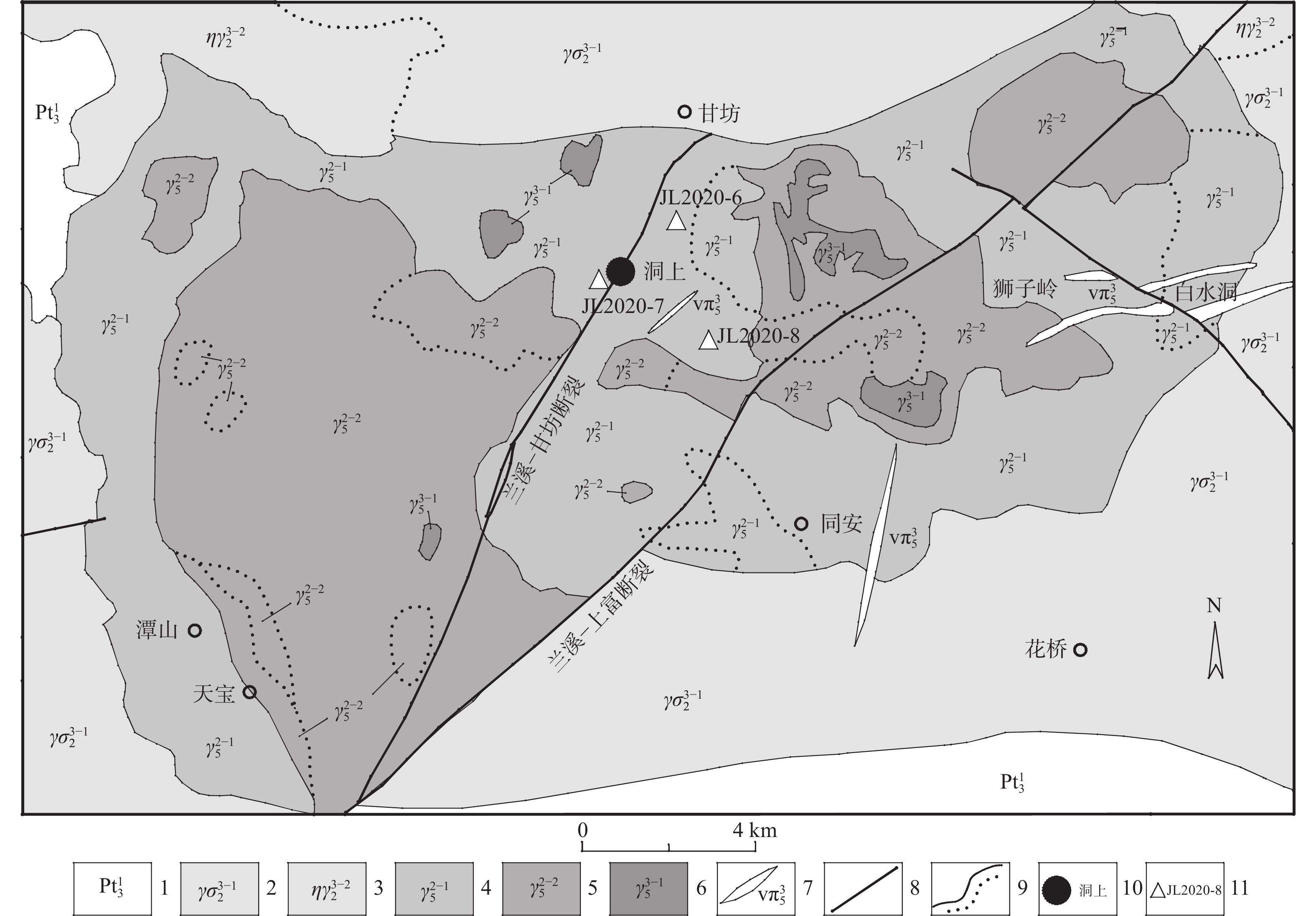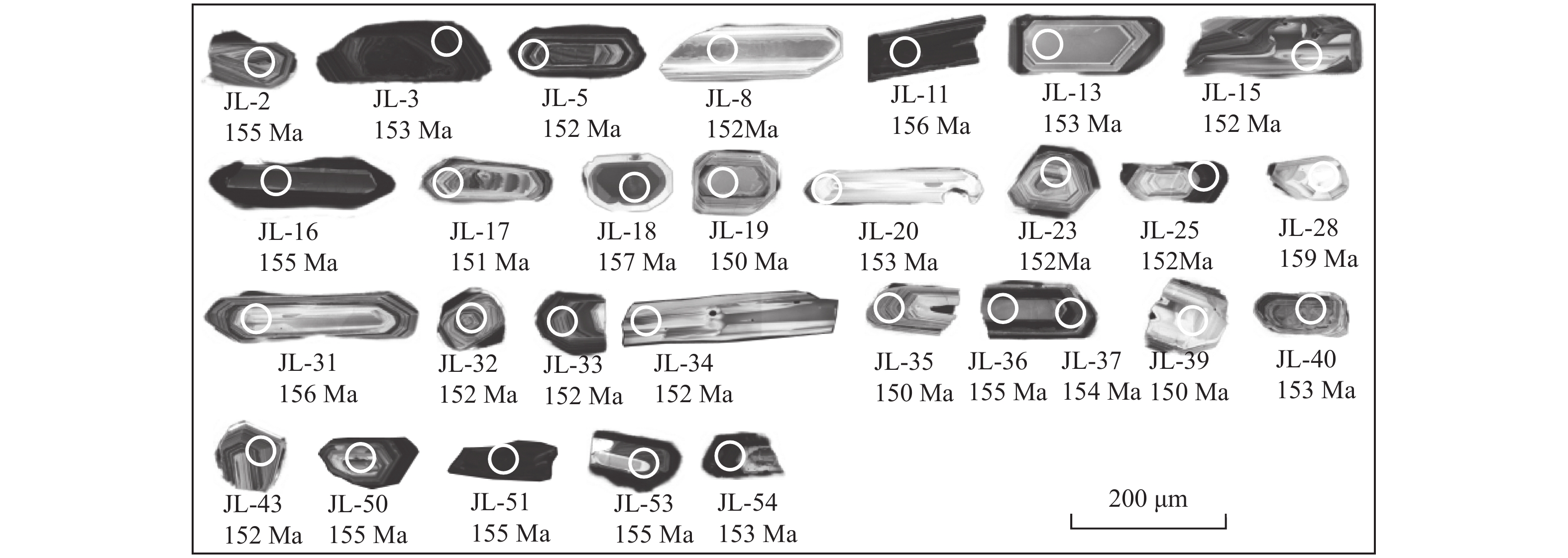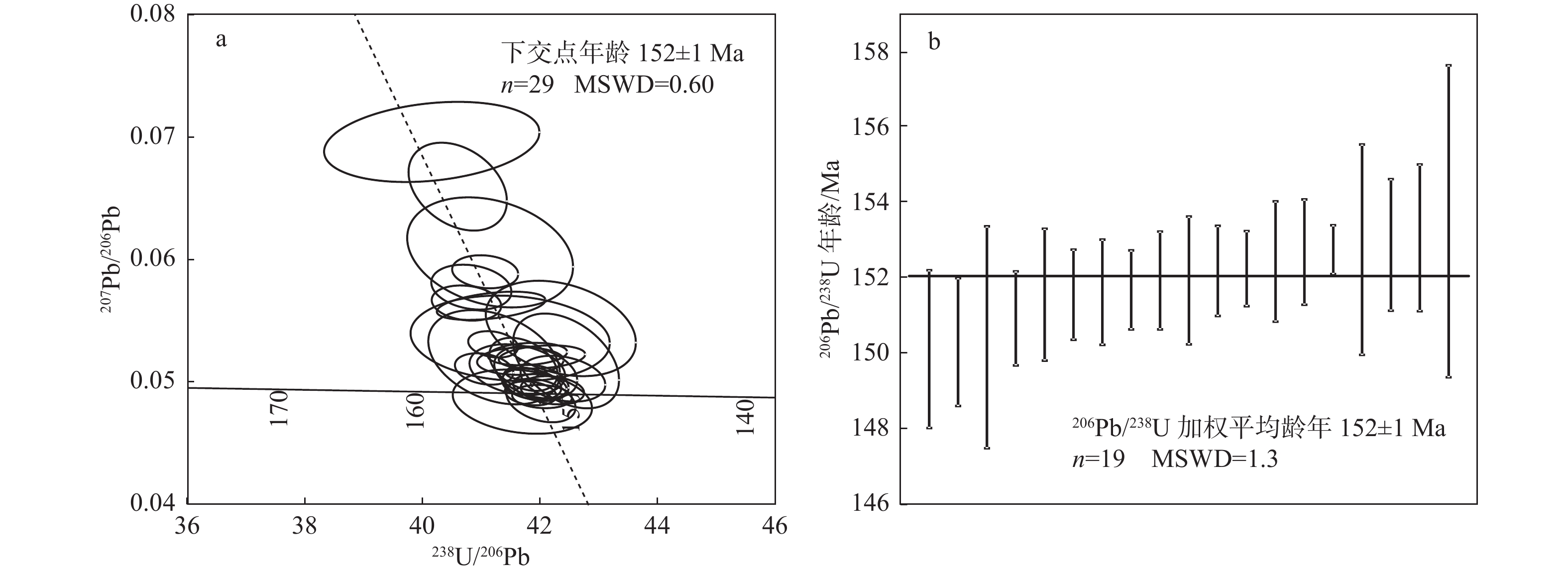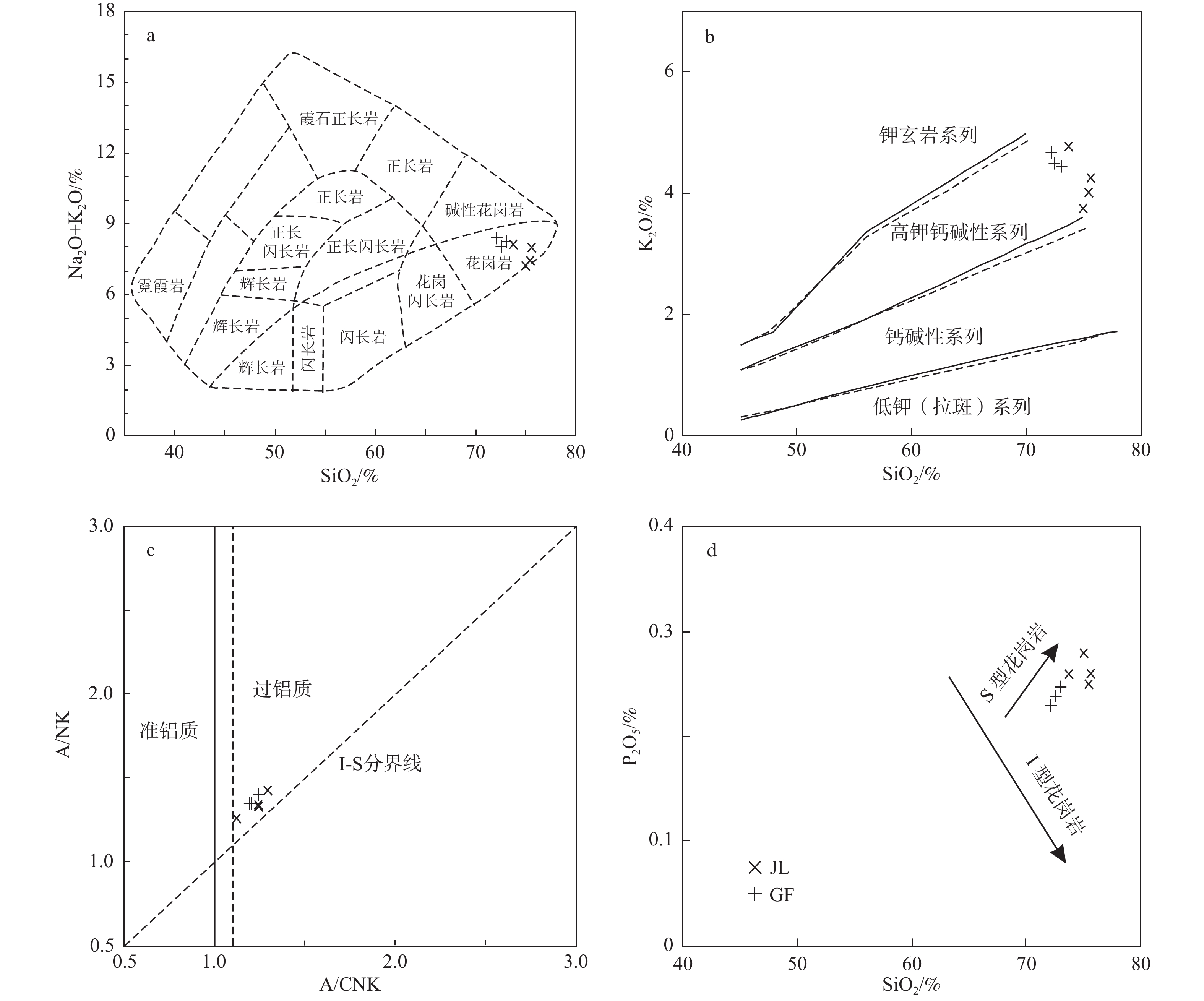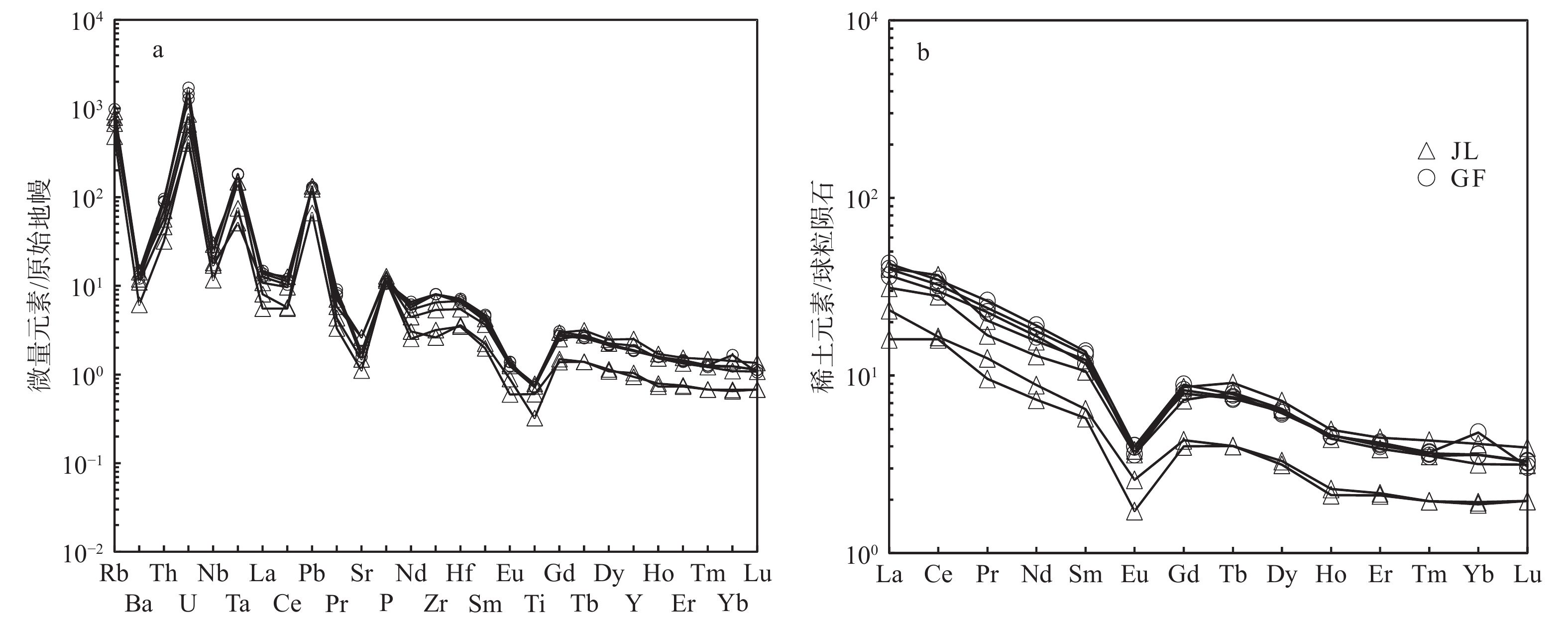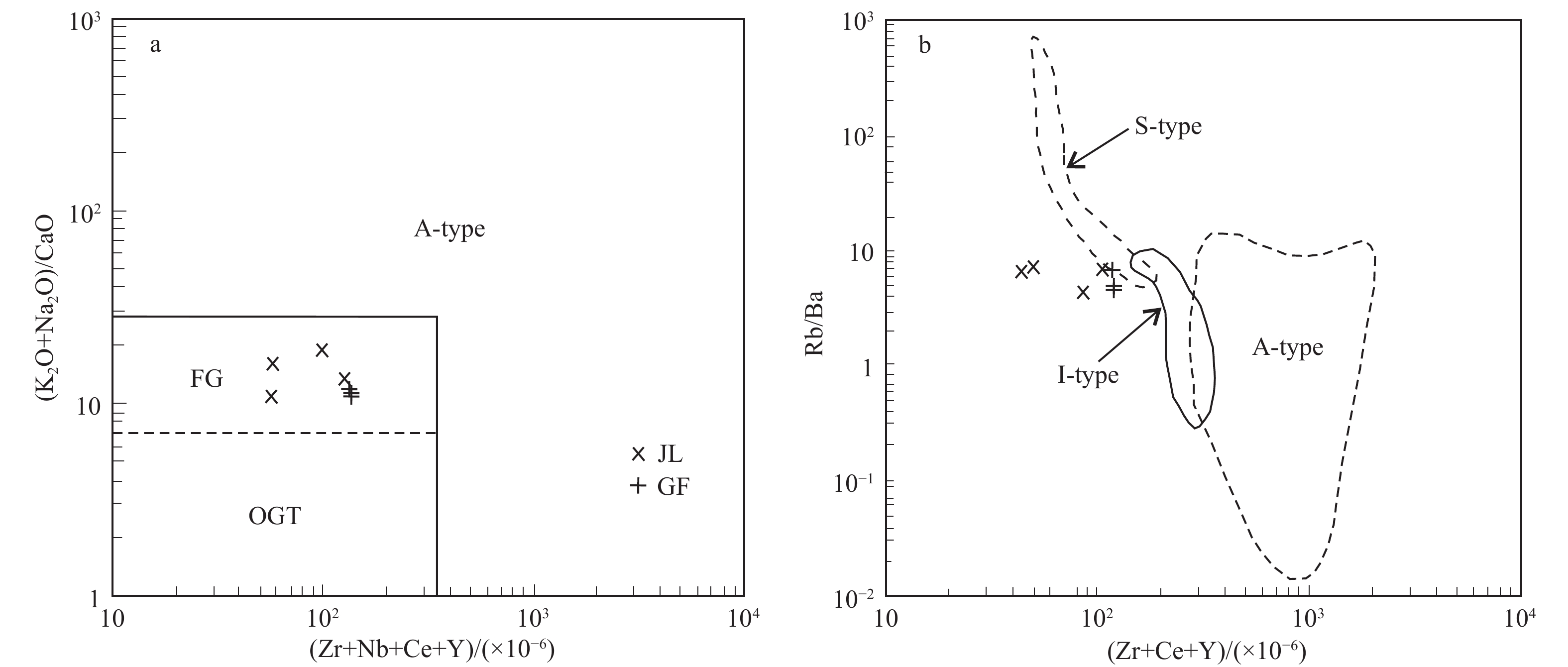Geochronology and petrogeochemical characteristics of U-bearing granites in the Dongshang deposit, northwestern Jiangxi, China and its geological significance
-
摘要: 洞上铀矿床位于赣西北九岭岩基南部甘坊岩体内,产铀花岗岩以中粗粒斑状黑(二)云母花岗岩为主。通过锆石及独居石U–Pb年代学、岩相学和岩石地球化学研究,确定产铀花岗岩的形成时代、源区属性与岩石成因,探讨其铀成矿潜力。LA–ICP–MS分析结果显示,锆石U–Pb下交点年龄和加权平均年龄均为152±1 Ma,独居石U-Pb下交点年龄和加权平均年龄分别为151±1 Ma和151±2 Ma,表明产铀花岗岩形成于燕山早期。主量元素具有高硅(SiO2含量为72.1%~75.6%)、高碱(K2O+Na2O含量为7.26%~8.43%)、富钾贫钠(K2O/Na2O=1.07~1.42)、高铝(A/CNK=1.12~1.29)、低钛(TiO2含量为0.07%~0.17%)、贫铁镁(FeOT含量为0.75%~1.28%、MgO含量为0.19%~0.31%)特征,属高钾钙碱性系列过铝质花岗岩;微量元素Ba、Sr、Nb、Ti亏损,Rb、U、Pb、Ta富集,属典型的低Ba、Sr花岗岩;稀土总量较低(∑REE=21.6×10−6~50.7×10−6),配分曲线为右倾的轻稀土富集型,Eu负异常明显,属S型花岗岩。结合年代学和岩石地球化学特征,认为洞上产铀花岗岩形成于燕山早期同碰撞造山的主挤压阶段,是新元古界双桥山群安乐林组富白云母的变泥质岩部分熔融的产物。富铀、Rb/Sr比值高、Th/U比值小于3、锆石铀含量高等特征指示该花岗岩为产铀花岗岩,具有提供铀源的条件与潜力。Abstract: The Dongshang Uranium Deposit is situated in the southern section of the Ganfang Pluton in the Jiuling Orogenic Belt of northwestern Jiangxi Province. The U-bearing granites consist mainly of medium- to coarse-grained, porphyritic biotite(binary) granite. Through zircon and monazite U-Pb geochronology, petrology, and rock geochemistry studies, the U-bearing granites' age, source characteristics, and rock genesis were determined, and their uranium metallogenic potential was also discussed. The LA-ICP-MS analysis showed that the zircon U-Pb intercept and weighted average ages are both 152±1 Ma, and the monazite U-Pb intercept and weighted average ages are 151±1 Ma and 151±2 Ma, respectively, indicating the formation of the U-bearing granites during the early Yanshan period. The major elements exhibit the characteristic of high silica content (SiO2 ranging from 72.1% to 75.6%), high alkalis content (K2O+Na2O ranging from 7.26% to 8.43%), potassium-rich and sodium-poor (K2O/Na2O=1.07 to 1.42), high aluminum (A/CNK=1.12 to 1.29), low titanium content (TiO2 ranging from 0.07% to 0.17%), and iron-poor magnesium (FeOT ranging from 0.75% to 1.28%, MgO ranging from 0.19% to 0.31%), classifying the U-bearing granites as high potassium calcalkaline peraluminous granites. Trace elements Ba, Sr, Nb, and Ti are depleted, while Rb, U, Pb, and Ta are enriched, representing a typical low Ba, Sr granite. The total rare earth elements (ΣREE) are relatively low (∑REE=21.6×10−6 to 50.7×10−6), exhibiting a right-dipping light rare earth enrichment pattern with a prominent negative Eu anomaly, which belongs to S-type granites. Based on geochronology and rock geochemical features, it's suggested that the Dongshang U-bearing granites were formed during the syn-collision compressional setting, resulting from the partial melting of the muscovite-rich metapelites of the Anlelin Formation in the Neoproterozoic Shuangqiaoshan Group. High uranium content, high Rb/Sr ratios, Th/U ratios less than 3, and high zircon uranium contents indicate the potential for uranium ore-forming conditions within these granites.
-
图 1 九岭地区大地构造位置及铀矿地质简图
1—第四系;2—古近系;3—上白垩统;4—奥陶系;5—寒武系;6—下南华统;7—新元古界双桥山群;8—晋宁期花岗岩;9—燕山早期第一阶段花岗岩;10—燕山早期第二阶段花岗岩;11—燕山晚期花岗岩;12—细晶岩脉、花岗斑岩脉;13—推滑覆断层、剥离断层;14—断裂构造;15—不整合界线;16—地质界线;17—岩相界线;18—铀矿床及名称a—大地构造位置简图(张勇,2018);b—铀矿地质简图
Figure 1. Geotectonic location map and uranium geological map of Jiuling area
(a) Geotectonic location map (Zhang, 2018); (b) Uranium geological map 1–Quaternary; 2–Paleogene; 3–Upper Cretaceous; 4–Ordovician; 5–Cambrian; 6–Lower Nanhuan System; 7–Neoproterozoic Shuangqiaoshan Group; 8–Granite of Jinning Period; 9–Granite of first stage in Early Yanshanian; 10–Granite of second stage in Early Yanshanian; 11–Granite of Late Yanshanian; 12–fine-grain dike or ranite-porphyry vein; 13–nappe structure; 14–fault structure; 15–unconformity; 16–geological boundary; 17–lithologic interface; 18–uranium deposit
图 2 洞上地区铀矿地质简图(据周建廷等,2011;秦程,2018修编)
1—新元古界双桥山群;2—晋宁期花岗闪长岩;3—晋宁期二长花岗岩;4—燕山早期第一阶段花岗岩;5—燕山早期第二阶段花岗岩;6—燕山晚期第一阶段花岗岩;7—细晶岩脉、花岗斑岩脉;8—断裂构造;9—地质界线、岩相界线;10—铀矿床及名称;11—取样位置及编号
Figure 2. Uranium geological map of Dongshang deposit(modified after Zhou et al., 2011; Qin, 2018)
1–Neoproterozoic Shuangqiaoshan Group; 2–granodiorite of Jinning Period; 3–monzonitic granite of Jinning Period; 4–granite of first stage in Early Yanshanian; 5–granite of second stage in Early Yanshanian; 6–granite of Late Yanshanian; 7–fine-grain dike or ranite-porphyry vein; 8–fault structure; 9–geological boundary or lithologic interface; 10–uranium deposit; 11–sampling point and number
图 3 洞上产铀花岗岩岩石学特征
Qtz—石英;Pl—斜长石;Ms—白云母;Chl—绿泥石;Kfs—钾长石a—浅肉红色中粗粒斑状黑(二)云母花岗岩;b—似斑状结构,图中石英斑晶超出视域(+);c—斜长石被白云母交代,绿泥石呈黑云母假晶(+);d—绿泥石和白云母组成黑云母的假晶(+);e—野外露头,发育钾长石化、褐铁矿化;f—岩石手标本,见钾长石化、水云母化
Figure 3. Petrological characteristics of the U-bearing granite in Dongshang deposit
(a) medium-coarse biotite granite; (b) orphyritic texture (+); (c) muscovitize (+); (d) chloritization and muscovitize (+); (e) K-alferation and ferritization of geological outcrop; (f) K-alferation and hydromicazation of hand specimens
图 7 洞上产铀花岗岩主量元素图解
JL数据为文中分析结果,GF数据引自王迪(2017)a—SiO2−(K2O+Na2O)图(Middlemost,1994);b—SiO2−K2O图(Peccerillo and Taylor,1976);c—A/CNK−ANK图(Maniar and Piccoli,1989);d—SiO2−P2O5图
Figure 7. Main element diagrams of the U-bearing granite in Dongshang deposit
(a) SiO2–(K2O+Na2O) diagram (Middlemost, 1994); (b)SiO2–K2O diagram (Peccerillo and Taylor, 1976); (c) A/CNK–ANK diagram (Maniar and Piccoli, 1989); (d) SiO2–P2O5 diagram The JL data was analyzed for this article; The GF data was quoted from Wang (2017).
图 8 洞上产铀花岗岩微量元素原始地幔标准化蛛网图及稀土元素球粒陨石标准化配分曲线(标准化数值引自Sun and McDonough (1989))
JL数据为此研究分析结果,GF数据引自王迪(2017)a—微量元素原始地幔标准化蛛网图;b—稀土元素球粒陨石标准化配分曲线
Figure 8. Primitive mantle-normalized trace element spider diagram and chondrite-normalized REE distribution pattern of the U-bearing granite in Dongshang deposit (normalized values after Sun and McDonough(1989))
(a) Primitive mantle-normalized trace element spider diagram; (b) Chondrite-normalized REE distribution patternThe JL data was analyzed for this article; The GF data was quoted from Wang (2017).
图 9 洞上产铀花岗岩岩石类型判别图解
FG—酸性花岗岩;OGT—未发生分异花岗岩;JL数据为文中分析结果,GF数据引自王迪(2017)a—(Zr+Nb+Ce+Y)−((K2O+Na2O)/Ca2O)图解(底图引自Whalen et al.(1987));b—(Zr+Ce+Y)−(Rb/Ba)图解(底图引自Whalen et al.(1987))
Figure 9. Discrimination diagrams for the rock-type of the U-bearing granite in Dongshang deposit
(a) (Zr+Nb+Ce+Y)–((K2O+Na2O)/Ca2O) diagram (Schema from Whalen et al.(1987)); (b) (Zr+Ce+Y)–(Rb/Ba) diagram (Schema from Whalen et al.(1987))
图 10 洞上产铀花岗岩源区属性判别图解
JL数据为文中分析结果,GF数据引自王迪(2017)a—Rb/Sr−Rb/Ba图解(底图引自Sylvester(1998));b—NK/MFT−NKMFT图解(底图引自Lee et al.(2003))
Figure 10. Discrimination diagrams for the source characteristics of the U-bearing granite in Dongshang deposit
(a) Rb/Sr–Rb/Ba diagram (Schema from Sylvester (1998)); (b) NK/MFT–NKMFT diagram (Schema from Lee et al. (2003))
图 11 洞上产铀花岗岩构造环境判别图解
syn-COLG—同碰撞花岗岩;WPG—板内花岗岩;post-COLG—后碰撞花岗岩;VAG—火山弧花岗岩;ORG—洋脊花岗岩;JL数据为文中分析结果,GF数据引自王迪(2017)a—Rb–(Y+Nb)图解(底图引自Pearce(1996));b—Ta–Yb图解(底图引自Pearce(1996))
Figure 11. Discrimination diagrams for the tectonic environment of the U-bearing granite in Dongshang deposit
(a) Rb–(Y+Nb) diagram (Schema from Pearce (1996)); (b)Ta–Yb diagram (Schema from Pearce (1996))
表 1 洞上产铀花岗岩锆石LA–ICP–MS U–Pb定年分析结果
Table 1. Data of LA–ICP–MS zircon U–Pb dating of the U-bearing granite in Dongshang deposit
测点号 含量/(×10−6) 同位素比值 年龄/Ma Pb Th U 207Pb/206Pb 1σ 207Pb/235U 1σ 206Pb/238U 1σ 207Pb/206Pb 1σ 207Pb/235U 1σ 206Pb/238U 1σ JL2020-7-02 16 237 691 0.0511 0.0010 0.1715 0.0035 0.0244 0.0002 244 40 161 3 155 1 JL2020-7-03 39 531 5890 0.0507 0.0003 0.1676 0.0013 0.0240 0.0001 227 16 157 1 153 1 JL2020-7-05 58 792 2140 0.0520 0.0005 0.1707 0.0025 0.0238 0.0003 287 22 160 2 152 2 JL2020-7-08 28 434 510 0.0499 0.0013 0.1642 0.0039 0.0239 0.0002 192 50 154 3 152 1 JL2020-7-11 127 1980 3700 0.0564 0.0009 0.1910 0.0040 0.0245 0.0002 470 33 177 3 156 2 JL2020-7-13 15 234 632 0.0484 0.0021 0.1600 0.0070 0.0240 0.0005 118 85 151 6 153 3 JL2020-7-15 14 192 725 0.0488 0.0008 0.1601 0.0026 0.0238 0.0002 139 33 151 2 152 1 JL2020-7-16 80 1022 3380 0.0531 0.0009 0.1776 0.0029 0.0243 0.0002 332 36 166 3 155 1 JL2020-7-17 22 295 607 0.0493 0.0009 0.1611 0.0031 0.0237 0.0002 163 38 152 3 151 1 JL2020-7-18 14 132 270 0.0660 0.0027 0.2240 0.0095 0.0246 0.0003 805 85 205 8 157 2 JL2020-7-19 12 179 225 0.0503 0.0016 0.1635 0.0049 0.0236 0.0003 207 60 154 5 150 2 JL2020-7-20 8 111 196 0.0514 0.0017 0.1700 0.0055 0.0240 0.0002 260 60 159 5 153 1 JL2020-7-23 26 384 523 0.0485 0.0014 0.1591 0.0046 0.0238 0.0002 123 60 150 4 152 1 JL2020-7-25 37 494 4680 0.0523 0.0007 0.1725 0.0025 0.0239 0.0003 298 31 162 2 152 2 JL2020-7-28 10 102 135 0.0696 0.0032 0.2390 0.0090 0.0249 0.0008 917 95 218 8 159 5 JL2020-7-31 23 310 361 0.0577 0.0015 0.1950 0.0050 0.0245 0.0003 520 55 181 4 156 2 JL2020-7-32 28 418 909 0.0496 0.0008 0.1629 0.0027 0.0238 0.0002 177 34 153 2 152 1 JL2020-7-33 24 308 720 0.0498 0.0010 0.1641 0.0034 0.0239 0.0002 187 42 154 3 152 1 JL2020-7-34 21 325 360 0.0508 0.0017 0.1670 0.0055 0.0239 0.0003 231 65 157 5 152 2 JL2020-7-35 11 125 333 0.0517 0.0029 0.1680 0.0095 0.0236 0.0003 273 120 158 9 150 2 JL2020-7-36 112 1560 3480 0.0562 0.0010 0.1883 0.0029 0.0243 0.0004 461 36 175 3 155 2 JL2020-7-37 43 458 3260 0.0536 0.0028 0.1780 0.0095 0.0241 0.0007 353 120 166 8 154 4 JL2020-7-39 13 167 168 0.0544 0.0032 0.1770 0.0100 0.0236 0.0005 386 120 165 9 150 3 JL2020-7-40 16 196 492 0.0510 0.0017 0.1690 0.0055 0.0240 0.0003 241 70 159 5 153 2 JL2020-7-43 18 276 761 0.0491 0.0008 0.1617 0.0026 0.0239 0.0002 151 33 152 2 152 1 JL2020-7-50 26 341 229 0.0520 0.0026 0.1740 0.0100 0.0243 0.0004 286 110 163 9 155 3 JL2020-7-51 40 504 1550 0.0590 0.0012 0.1981 0.0037 0.0244 0.0002 567 46 184 3 155 1 JL2020-7-53 28 285 247 0.0606 0.0037 0.2030 0.0120 0.0243 0.0006 625 125 188 10 155 3 JL2020-7-54 20 265 5050 0.0517 0.0007 0.1711 0.0031 0.0240 0.0003 272 31 160 3 153 2 表 2 洞上产铀花岗岩独居石LA–ICP–MS U–Pb定年分析结果
Table 2. Data of LA–ICP–MS monaite U–Pb dating of the U-bearing granite in Dongshang deposit
测点号 含量/(×10−6) 同位素比值 年龄/Ma Th U 207Pb/235U 2σ 206Pb/238U 2σ 207Pb/235U 2σ 206Pb/238U 2σ JLD2020-7-01 191064 11305 0.1530 0.0095 0.0230 0.0007 145 8 147 5 JLD2020-7-03 176267 7805 0.1592 0.0096 0.0244 0.0007 150 8 156 5 JLD2020-7-04 179808 3833 0.1794 0.0176 0.0241 0.0008 168 15 153 5 JLD2020-7-05 179094 9668 0.1589 0.0095 0.0239 0.0007 150 8 152 5 JLD2020-7-07 217554 3884 0.1591 0.0132 0.0236 0.0007 150 12 151 5 JLD2020-7-09 185410 7891 0.1733 0.0103 0.0240 0.0008 162 9 153 5 JLD2020-7-10 185511 6457 0.1512 0.0086 0.0237 0.0007 143 8 151 5 JLD2020-7-13 187573 10423 0.1592 0.0088 0.0233 0.0006 150 8 148 4 JLD2020-7-15 161676 6801 0.1586 0.0123 0.0242 0.0007 149 11 154 5 JLD2020-7-16 181397 6335 0.1616 0.0096 0.0242 0.0007 152 8 154 5 JLD2020-7-17 88445 12300 0.1550 0.0089 0.0235 0.0007 146 8 150 4 JLD2020-7-18 182585 7128 0.1611 0.0104 0.0237 0.0006 152 9 151 4 JLD2020-7-19 180762 5964 0.1689 0.0132 0.0240 0.0007 158 11 153 5 JLD2020-7-21 187512 9102 0.1572 0.0096 0.0235 0.0006 148 8 150 4 JLD2020-7-24 131495 27231 0.1476 0.0069 0.0229 0.0007 140 6 146 4 JLD2020-7-02 104575 13748 0.4302 0.0349 0.0273 0.0009 363 25 174 6 JLD2020-7-11 231240 2392 0.8941 0.1181 0.0314 0.0013 649 63 199 8 JLD2020-7-20 177503 5259 0.7670 0.1135 0.0304 0.0014 578 65 193 9 JLD2020-7-22 176812 4865 0.2169 0.0160 0.0246 0.0008 199 13 156 5 表 3 洞上产铀花岗岩主量元素(%)、微量元素(×10−6)及稀土元素(×10−6)分析结果
Table 3. The analytical results major elements (%), trace elements (×10−6) and REEs (×10−6) of the U-bearing granite in Dongshang deposit
样号 JL2020-6 JL2020-7 JL2020-8 GF8-1 GF9-1 GF10-1 GF11-1 元素 中粗粒斑状黑(二)云母花岗岩 粗粒白云母花岗岩 SiO2 72.14 73.01 72.51 75.40 73.70 75.00 75.60 TiO2 0.15 0.16 0.16 0.13 0.16 0.17 0.07 Al2O3 15.17 14.93 14.97 13.50 14.30 14.00 13.60 FeOT 1.28 1.13 1.27 0.85 1.02 1.20 0.75 MnO 0.07 0.06 0.08 0.04 0.03 0.08 0.50 MgO 0.27 0.23 0.25 0.25 0.31 0.30 0.19 CaO 0.72 0.76 0.72 0.47 0.43 0.54 0.74 Na2O 3.78 3.82 3.55 3.47 3.36 3.51 3.78 K2O 4.65 4.44 4.49 4.01 4.77 3.75 4.25 P2O5 0.23 0.25 0.24 0.25 0.26 0.28 0.26 LOI 1.13 1.15 1.03 0.77 0.77 0.96 1.55 总量 99.60 99.96 99.30 99.10 99.60 99.76 100.76 K2O+Na2O 8.43 8.26 8.04 7.48 8.13 7.26 8.03 K2O/Na2O 1.23 1.16 1.26 1.16 1.42 1.07 1.12 CaO/Na2O 0.19 0.20 0.20 0.14 0.13 0.15 0.20 Al2O3/TiO2 101.13 93.31 93.56 103.85 89.38 82.35 194.29 A/CNK 1.21 1.20 1.25 1.24 1.25 1.29 1.12 A/NK 1.35 1.35 1.40 1.34 1.34 1.42 1.26 C/FM 0.47 0.56 0.47 0.43 0.32 0.36 0.79 A/FM 9.81 10.96 9.84 12.27 10.75 9.33 14.47 Rb 622.00 414.00 448.00 305.00 430.00 580.00 500.00 Sr 37.60 33.40 37.90 23.40 55.20 55.40 31.30 Y 8.50 8.58 8.37 4.30 9.63 11.40 4.73 Zr 90.00 90.00 90.00 35.60 59.90 72.80 29.30 Hf 2.01 2.12 2.21 1.07 1.69 2.08 1.11 Nb 16.70 17.10 16.70 8.30 12.10 20.90 12.90 Ta 7.41 7.39 7.51 3.07 2.09 6.07 6.03 Ba 96.70 84.50 102.00 42.80 99.70 83.00 76.70 Th 7.62 7.49 8.11 2.71 4.79 5.96 3.94 U 30.80 35.90 27.20 9.20 13.90 18.00 8.44 Pb 23.20 23.00 23.90 12.30 24.50 22.70 24.40 Ti 930.00 940.00 940.00 779.00 959.00 1019.00 420.00 P 999.00 1077.00 1038.00 1090.00 1134.00 1221.00 1134.00 Rb/Sr 16.50 12.40 11.80 13.00 7.79 10.50 16.00 Rb/Ba 6.43 4.90 4.39 7.13 4.31 6.99 6.52 Rb/Nb 37.20 24.20 26.80 36.70 35.50 27.80 38.80 Zr/Hf 44.80 42.50 40.70 33.30 35.40 35.00 26.40 Th/U 0.25 0.21 0.30 0.29 0.34 0.33 0.47 La 8.68 9.42 10.10 3.79 7.41 9.56 5.54 Ce 18.30 19.92 21.24 9.79 17.20 22.50 10.14 Pr 2.16 2.28 2.50 0.91 1.60 1.94 1.19 Nd 7.78 8.34 8.94 3.42 6.03 7.31 4.14 Sm 1.79 2.01 2.09 0.88 1.62 1.88 0.99 Eu 0.23 0.21 0.23 0.10 0.21 0.22 0.15 Gd 1.63 1.70 1.83 0.82 1.50 1.77 0.89 Tb 0.28 0.28 0.29 0.15 0.30 0.34 0.15 Dy 1.59 1.62 1.56 0.84 1.65 1.83 0.80 Ho 0.26 0.26 0.26 0.13 0.25 0.28 0.12 Er 0.67 0.68 0.69 0.36 0.64 0.74 0.35 Tm 0.09 0.09 0.09 0.05 0.09 0.11 0.05 Yb 0.61 0.61 0.81 0.32 0.54 0.70 0.33 Lu 0.08 0.08 0.08 0.05 0.08 0.10 0.05 ∑REE 44.16 47.49 50.69 21.61 39.12 49.28 24.85 LREE/HREE 7.47 7.92 8.01 6.94 6.75 7.40 8.07 δEu 0.41 0.34 0.35 0.35 0.40 0.36 0.48 (La/Yb)N 10.21 11.13 8.90 8.50 9.84 9.80 12.04 (La/Sm)N 3.13 3.03 3.12 2.78 2.95 3.28 3.61 (Gd/Yb)N 2.21 2.32 1.86 2.12 2.30 2.09 2.23 Zr+Nb+Ce+Y 739.00 523.00 558.00 419.00 532.00 676.00 706.00 表 4 洞上产铀花岗岩、长江岩体、打鼓寨岩体岩石地球化学组分对比表
Table 4. Comparison table of petrogeochemical components of Dongshang U-bearing granite, Changjiang granite and Daguzhai granite
岩体 SiO2/% K2O+Na2O/% K2O/Na2O CaO/Na2O A/CNK ∑REE/(×10−6) LREE/HREE δEu 长江 74.00 8.22 1.81 0.31 1.11 197.0 7.38 0.21 洞上 73.90 7.95 1.20 0.17 1.22 39.6 7.51 0.39 打鼓寨 73.20 8.39 1.69 0.22 1.22 205.0 4.43 0.33 岩体 (Zr+Nb+Ce+Y)/(×10−6) Zr/Hf Rb/Sr U/(×10−6) Th/U 锆石U/(×10−6) 锆石Th/(×10−6) 锆石Th/U 长江 252.00 24.60 10.50 18.00 2.22 2453 1084 0.75 洞上 107.00 36.90 12.60 20.50 0.31 2592 660 0.49 打鼓寨 249.00 33.20 6.75 19.50 2.45 68348 33230 0.48 注:打鼓寨岩体数据引自徐勋胜等(2021),长江岩体数据引自田泽瑾(2014) -
[1] China National Nuclear Corporation, 1996. Prospecting guidebook on granite-related uranium deposits: EJ/T 996—1996 [S]. Beijing: Nuclear Industry Standardization Institute: 1-67. (in Chinese) [2] CHEN D, LUO P, ZENG Z F, et al. , 2022. Petrogenesis and implications of the Dupangling compound granite in southern Hunan Province, China: Constraints from mineralogical chemistry, zircon U-Pb age, geochemistry and Nd-Hf isotope[J]. Journal of Geomechanics, 28(4): 617-641. (in Chinese with English abstract) [3] CHEN Z Y, WANG D H, 2014. The significance of Th, U contents and Th/U ratios of zircons in distinguishing uranium-producing and non-uranium-producing granites[J]. Mineral Deposits, 33(S1): 1159-1160. (in Chinese) DONG S W, ZHANG Y Q, LONG C X, et al. , 2007. Jurassic tectonic revolution in China and new interpretation of the Yanshan Movement[J]. Acta Geologica Sinica, 81(11): 1449-1461. (in Chinese with English abstract) [4] DOU X P, 2004. Genetic types of granitoids in eastern China and their relationship to uranium metallogenesis[J]. Uranium Geology, 20(6): 330-336. (in Chinese with English abstract) [5] DOU X P, XIONG C, DU X S, et al. , 2015. Study on uranium contents and the characteristics of migration enrichment in some granitic plutons of East China[J]. World Nuclear Geoscience, 32(3): 145-151. (in Chinese with English abstract) [6] DUAN Z, LIAO S B, CHU P L, et al. , 2019. Zircon U-Pb ages of the Neoproterozoic Jiuling complex granitoid in the eastern segment of the Jiangnan orogen and its tectonic significance[J]. Geology in China, 46(3): 493-516. (in Chinese with English abstract) [7] GUO C L, CHEN Z Y, LOU F S, et al. , 2014. Geochemical characteristics and genetic types of the W-Sn bearing Late Jurassic granites in the Nanling region[J]. Geotectonica et Metallogenia, 38(2): 301-311. (in Chinese with English abstract) [8] GUO X F,WANG Q L,JING Y H,et al, 2022.Zircon U-Pb Geochronology and Hf Isotope Characteristics of the Xihuashan Granites in Southern Jiangxi Province and Their Geological Significance[J].Geology and Exploration, 58(3):585-597.(in Chinese with English abstract) [9] HARRIS N B W, INGER S, 1992. Trace element modelling of pelite-derived granites[J]. Contributions to Mineralogy and Petrology, 110(1): 46-56. doi: 10.1007/BF00310881 [10] JIANG S Y, PENG N J, HUANG L C, et al. , 2015. Geological characteristic and ore genesis of the giant tungsten deposits from the Dahutang ore-concentrated district in northern Jiangxi Province[J]. Acta Petrologica Sinica, 31(3): 639-655. (in Chinese with English abstract) [11] LAN H F, LING H F, SUN L Q, et al. , 2016. Study on petrogenesis and uranium mineralization potential of Taojindong granite in southern Zhuguangshan composite pluton[J]. Geological Journal of China Universities, 22(1): 12-29. (in Chinese with English abstract) [12] LEE S Y, BARNES C G, SNOKE A W, et al. , 2003. Petrogenesis of Mesozoic, Peraluminous granites in the Lamoille Canyon area, Ruby Mountains, Nevada, USA[J]. Journal of Petrology, 44(4): 713-732. doi: 10.1093/petrology/44.4.713 [13] LING H F, SHEN W Z, SUN T, et al. , 2006. Genesis and source characteristics of 22 Yanshanian granites in Guangdong province: study of element and Nd-Sr isotopes[J]. Acta Petrologica Sinica, 22(11): 2687-2703. (in Chinese with English abstract) [14] LIU Y, 2019. The mineralogical characteristics of the rare-metal granites in Jiuling district, Jiangxi province and the implication for the various metallogenic mechanism[D]. Nanjing University. (in Chinese with English abstract) [15] LIU Y S, HU Z C, GAO S, et al. , 2008. In situ analysis of major and trace elements of anhydrous minerals by LA-ICP-MS without applying an internal standard[J]. Chemical Geology, 257(1-2): 34-43. doi: 10.1016/j.chemgeo.2008.08.004 [16] LIU Y S, GAO S, HU Z C, et al. , 2010. Continental and oceanic crust recycling-induced melt–peridotite interactions in the Trans-North China Orogen: U–Pb dating, Hf isotopes and trace elements in zircons from mantle xenoliths[J]. Journal of Petrology, 51(1-2): 537-571. doi: 10.1093/petrology/egp082 [17] LUDWIG K R, 2003. Isoplot/Ex, Version 3.00: a geochronological toolkit for Microsoft Excel[M]. Berkeley: Berkeley Geochronology Center. [18] MANIAR P D, PICCOLI P M, 1989. Tectonic discrimination of granitoids[J]. GSA Bulletin, 101(5): 635-643. doi: 10.1130/0016-7606(1989)101<0635:TDOG>2.3.CO;2 [19] MAO J W, XIE G Q, GUO C L, et al. , 2008. Spatial-temporal distribution of Mesozoic Ore Deposits in South China and their metallogenic settings[J]. Geological Journal of China Universities, 14(4): 510-526. (in Chinese with English abstract) [20] MAO J W, CHEN M H, YUAN S D, et al. , 2011. Geological characteristics of the Qinhang (or Shihang) metallogenic belt in South China and spatial-temporal distribution regularity of mineral deposits[J]. Acta Geologica Sinica, 85(5): 636-658. (in Chinese with English abstract) [21] MIDDLEMOST E A K, 1994. Naming materials in the magma/igneous rock system[J]. Earth-Science Reviews, 37(3-4): 215-224. doi: 10.1016/0012-8252(94)90029-9 [22] PEARCE J, 1996. Sources and settings of granitic rocks[J]. Episodes, 19(4): 120-125. doi: 10.18814/epiiugs/1996/v19i4/005 [23] PECCERILLO A, TAYLOR S R, 1976. Geochemistry of Eocene calc-alkaline volcanic rocks from the Kastamonu area, northern Turkey[J]. Contributions to Mineralogy and Petrology, 58(1): 63-81. doi: 10.1007/BF00384745 [24] QIN C, 2018. Preliminary study of mineralization potentiality of Shiziling muscovite granite, Jiangxi province[D]. Beijing: China University of Geosciences (Beijing). (in Chinese with English abstract) [25] SONG B, ZHANG Y H, WAN Y S, et al. , 2002. Mount making and procedure of the SHRIMP dating[J]. Geological Review, 48(S1): 26-30. (in Chinese with English abstract) [26] SUN J D,LI H L,LU F,et al, 2022.Geochemistry,Zircon U-Pb Ages,and Hf Isotopes of the Mengshan Rock Mass in Western Jiangxi Province and Their Geologic Implications[J].Geology and Exploration, 58(1):96-107. (in Chinese with English abstract) [27] SUN S S, MCDONOUGH W F, 1989. Chemical and isotopic systematics of oceanic basalts: implications for mantle composition and processes[J]. Geological Society, London, Special Publications, 42(1): 313-345. doi: 10.1144/GSL.SP.1989.042.01.19 [28] SYLVESTER P J, 1998. Post-collisional strongly peraluminous granites[J]. Lithos, 45(1-4): 29-44. doi: 10.1016/S0024-4937(98)00024-3 [29] TAN J, WEI J H, LI Y J, et al. , 2007. Some reviews on diagenesis and metallogeny of the Mesozoic crustal remelting granitoids in the Nanling region[J]. Geological Review, 53(3): 349-362. (in Chinese with English abstract) [30] TIAN Z J, 2014. Uranium-bearing and barren granites from the Zhuguang mountain: geochronology, Element geochemistry, mineralogy comparison[D]. Beijing: China University of Geosciences (Beijing). (in Chinese with English abstract) [31] WANG D, 2017. Formation of huge granitic batholiths in Jiuling area of North Jiangxi province[D]. Nanjing: Nanjing University. (in Chinese with English abstract) [32] WANG L J, WANG J B, WANG Y Z, et al. , 2013. Geological characteristics of host granite intrusions of the W-Sn-Nb-Ta deposit, Nanling area, China[J]. Minerl Exploration, 4(6): 598-608. (in Chinese with English abstract) [33] WANG T, GUO L, LI S, et al. , 2019. Some important issues in the study of granite tectonics[J]. Journal of Geomechanics, 25(5): 899-919. (in Chinese with English abstract) [34] WANG W L, TENG X J, LIU Y, et al. , 2017. Zircon U-Pb chronology and geochemical characteristics of the Wuheertu granite mass in Langshan, Inner Mongolia[J]. Journal of Geomechanics, 23(3): 382-396. (in Chinese with English abstract) [35] WHALEN J B, CURRIE K L, CHAPPELL B W, 1987. A-type granites: geochemical characteristics, discrimination and petrogenesis[J]. Contributions to Mineralogy and Petrology, 95(4): 407-419. doi: 10.1007/BF00402202 [36] WU Y B, ZHENG Y F, 2004. Genesis of zircon and its constraints on interpretation of U-Pb age[J]. Chinese Science Bulletin, 49(15): 1554-1569. doi: 10.1007/BF03184122 [37] XIANG X K, YIN Q Q, SUN K K, et al. , 2015a. Origin of the Dahutang syn-collisional granite-porphyry in the middle segment of the Jiangnan orogen: zircon U-Pb geochronologic, geochemical and Nd-Hf isotopic constraints[J]. Acta Petrologica et Mineralogica, 34(5): 581-600. (in Chinese with English abstract) [38] XIANG X K, YIN Q Q, FENG C Y, et al. , 2015b. Elements and fluids migration regularity of granodiorite alteration zones in the Shimensi tungsten polymetallic deposit in northern Jiangxi and their constrain on mineralization[J]. Acta Geologica Sinica, 89(7): 1273-1287. (in Chinese with English abstract) [39] XIAO Z B, WANG H C, KANG J L, et al. , 2017. U-Pb chronology, Hf isotope and geological implication of zircons from the Neoarchean quartzite in Changyi area, eastern Shandong[J]. Acta Petrologica Sinica, 33(9): 2925-2938. (in Chinese with English abstract) [40] XIE L, LIU Y, WANG R C, et al. , 2019. Li–Nb–Ta mineralization in the Jurassic Yifeng Granite-aplite intrusion within the Neoproterozoic Jiuling batholith, South China: a fluid-rich and Quenching Ore-forming process[J]. Journal of Asian Earth Sciences, 185(17): 104047. [41] XU X S, ZHANG H, WU Y, et al. , 2021. Disintegration of Daguzhai composite pluton in South Jiangxi and its geological implication[J]. Uranium Geology, 37(3): 398-405. (in Chinese with English abstract) [42] ZHANG D, LI F, HE X L, et al. , 2021. Mesozoic tectonic deformation and its rock / ore-control mechanism in the important metallogenic belts in South China[J]. Journal of Geomechanics, 27(4): 497-528. (in Chinese with English abstract) [43] ZHANG Y, PAN J Y, MA D S, et al. , 2017. Re-Os molybdenite age of Dawutang tungsten ore district of northwest Jiangxi and its geological significance[J]. Mineral Deposits, 36(3): 749-769. (in Chinese with English abstract) [44] ZHANG Y, 2018. Ore-forming fluid evolution and Sb-Au-W metallogenesis in the Central Hunan-northwestern Jiangxi, South China[D]. Nanjing: Nanjing University. (in Chinese with English abstract) [45] ZHANG Y, LIU N Q, PAN J Y, et al. , 2019. Multi-mineralization stages of the Shimengsi giant tungsten deposit of Northwest Jiangxi: the application of cumulative frequency distribution in tungsten ore genesis and ore prospecting[J]. Journal of East China University of Technology, 42(4): 334-341, 367. (in Chinese with English abstract) [46] ZHANG Y, PAN J Y, MA D S, et al. , 2020. Lithium element enrichment and inspiration for prospecting for rare-metal mineralization in the Dahutang tungsten deposit: constraints from mineralogy and geochemistry of hydrothermal alteration[J]. Acta Geologica Sinica, 94(11): 3321-3342. (in Chinese with English abstract) [47] ZHANG Y Q, DONG S W, ZHAO Y, et al. , 2007. Jurassic tectonics of North China: a synthetic view[J]. Acta Geologica Sinica, 81(11): 1462-1480. (in Chinese with English abstract) [48] ZHAO F M, 2011. Research and evaluation of uranium deposits in China (volume IV): carbonaceous-siliceous-pelitic rock type uranium deposit[M]. Beijing: China Nuclear Geology. (in Chinese) [49] ZHAO Z H, 1992. Trace element geochemical[J]. Advances in Earth Science, 7(5): 65-66. (in Chinese) [50] ZHAO Z H, ZHOU L D, 1997. REE geochemistry of some alkali-rich intrusive rocks in China[J]. Science in China Series D: Earth Sciences, 40(2): 145-158. doi: 10.1007/BF02878373 [51] ZHOU J T, WANG G B, HE S F, et al. , 2011. Diagenesis and mineralization of Ganfang rock in Yifeng, Jiangxi province[J]. Journal of East China Institute of Technology, 34(4): 345-351, 358. (in Chinese with English abstract) [52] 陈迪, 罗鹏, 曾志方, 等, 2022. 湘南都庞岭复式花岗岩成因及地质意义: 矿物化学、锆石U-Pb年代学、地球化学与Nd-Hf同位素制约[J]. 地质力学学报, 28(4): 617-641. [53] 陈振宇, 王登红, 2014. 锆石Th、U含量和Th/U比值对产铀、不产铀花岗岩体的判别意义[J]. 矿床地质, 33(S1): 1159-1160. [54] 董树文, 张岳桥, 龙长兴, 等, 2007. 中国侏罗纪构造变革与燕山运动新诠释[J]. 地质学报, 81(11): 1449-1461. [55] 窦小平, 2004. 华东地区花岗岩类成因类型及其与铀成矿的关系[J]. 铀矿地质, 20(6): 330-336. [56] 窦小平, 熊超, 杜兴胜, 等, 2015. 华东地区部分花岗岩体铀含量及迁移富集特征研究[J]. 世界核地质科学, 32(3): 145-151. [57] 段政, 廖圣兵, 褚平利, 等, 2019. 江南造山带东段新元古代九岭复式岩体锆石U-Pb年代学及构造意义[J]. 中国地质, 46(3): 493-516. [58] 郭春丽, 陈振宇, 楼法生, 等, 2014. 南岭与钨锡矿床有关晚侏罗世花岗岩的成矿专属性研究[J]. 大地构造与成矿学, 38(2): 301-311. [59] 郭小飞,王庆龙,荆一洪,等, 2022.赣南西华山成矿花岗岩锆石U-Pb年代学和Hf同位素特征及其地质意义[J].地质与勘探, 58(3):585-597. [60] 蒋少涌, 彭宁俊, 黄兰椿, 等, 2015. 赣北大湖塘矿集区超大型钨矿地质特征及成因探讨[J]. 岩石学报, 31(3): 639-655. [61] 兰鸿锋, 凌洪飞, 孙立强, 等, 2016. 诸广山南体桃金洞花岗岩成因和铀成矿潜力探讨[J]. 高校地质学报, 22(1): 12-29. [62] 凌洪飞, 沈渭洲, 孙涛, 等, 2006. 广东省22个燕山期花岗岩的源区特征及成因: 元素及Nd-Sr同位素研究[J]. 岩石学报, 22(11): 2687-2703. [63] 刘莹, 2019. 江西九岭地区稀有金属花岗岩矿物学特征与成矿机制差异性研究[D]. 南京大学. [64] 毛景文, 谢桂青, 郭春丽, 等, 2008. 华南地区中生代主要金属矿床时空分布规律和成矿环境[J]. 高校地质学报, 14(4): 510-526. [65] 毛景文, 陈懋弘, 袁顺达, 等, 2011. 华南地区钦杭成矿带地质特征和矿床时空分布规律[J]. 地质学报, 85(5): 636-658. [66] 秦程, 2018. 江西宜丰狮子岭白云母花岗岩成矿潜力研究[D]. 北京: 中国地质大学(北京). [67] 宋彪, 张玉海, 万渝生, 等, 2002. 锆石SHRIMP样品靶制作、年龄测定及有关现象讨论[J]. 地质论评, 48(S1): 26-30. [68] 孙建东, 李海立, 陆凡, 等, 2022.赣西蒙山岩体地球化学、锆石U-Pb年龄、Hf同位素特征及地质意义[J].地质与勘探, 58(1):96-107. [69] 谭俊, 魏俊浩, 李艳军, 等, 2007. 南岭中生代陆壳重熔型花岗岩类成岩成矿的有关问题[J]. 地质论评, 53(3): 349-362. [70] 田泽瑾, 2014. 诸广山产铀与不产铀花岗岩的年代学、地球化学及矿物学特征对比研究[D]. 北京: 中国地质大学(北京). [71] 王迪, 2017. 赣北九岭地区巨型复式花岗岩基的形成[D]. 南京: 南京大学. [72] 王莉娟, 王京彬, 王玉往, 等, 2013. 我国南岭地区钨锡铌钽矿床成矿花岗岩主要地质特征[J]. 矿产勘查, 4(6): 598-608. [73] 王涛, 郭磊, 李舢, 等, 2019. 花岗岩大地构造研究的若干重要问题[J]. 地质力学学报, 25(5): 899-919. [74] 王文龙, 滕学建, 刘洋, 等, 2017. 内蒙古狼山乌和尔图花岗岩岩体锆石U-Pb年代学及地球化学特征[J]. 地质力学学报, 23(3): 382-396. [75] 吴元保, 郑永飞, 2004. 锆石成因矿物学研究及其对U-Pb年龄解释的制约[J]. 科学通报, 49(16): 1589-1604. [76] 项新葵, 尹青青, 孙克克, 等, 2015a. 江南造山带中段大湖塘同构造花岗斑岩的成因: 锆石U-Pb年代学、地球化学和Nd-Hf同位素制约[J]. 岩石矿物学杂志, 34(5): 581-600. [77] 项新葵, 尹青青, 丰成友, 等, 2015b. 赣北石门寺钨多金属矿床花岗闪长岩蚀变带元素、流体迁移规律及其对成矿作用的制约[J]. 地质学报, 89(7): 1273-1287. [78] 肖志斌, 王惠初, 康健丽, 等, 2017. 胶东昌邑地区新太古代石英岩的锆石U-Pb年代学和Hf同位素特征及其地质意义[J]. 岩石学报, 33(9): 2925-2938. [79] 徐勋胜, 张鸿, 吴勇, 等, 2021. 赣南打古寨复式花岗岩体的解体及其地质意义[J]. 铀矿地质, 37(3): 398-405. [80] 张达, 李芳, 贺晓龙, 等, 2021. 华南重要成矿区带中生代构造变形及其控岩控矿机理[J]. 地质力学学报, 27(4): 497-528. [81] 张勇, 潘家永, 马东升, 等, 2017. 赣西北大雾塘钨矿区地质特征及Re-Os同位素年代学研究[J]. 矿床地质, 36(3): 749-769. [82] 张勇, 2018. 湘中-赣西北成矿流体演化与Sb-Au-W成矿[D]. 南京: 南京大学. [83] 张勇, 刘南庆, 潘家永, 等, 2019. 赣西北石门寺超大型钨矿床多期成矿作用: 累积概率格纸在钨矿成因及找矿中的应用[J]. 东华理工大学学报(自然科学版), 42(4): 334-341, 367. [84] 张勇, 潘家永, 马东升, 2020. 赣西北大湖塘钨矿富锂-云母化岩锂元素富集机制及其对锂等稀有金属找矿的启示[J]. 地质学报, 94(11): 3321-3342. [85] 张岳桥, 董树文, 赵越, 等, 2007. 华北侏罗纪大地构造: 综评与新认识[J]. 地质学报, 81(11): 1462-1480. [86] 赵凤民, 2011. 中国铀矿床研究评价(第四卷): 碳硅泥岩型铀矿床[M]. 北京: 中国核工业地质局. [87] 赵振华, 1992. 微量元素地球化学[J]. 地球科学进展, 7(5): 65-66. [88] 中国核工业总公司, 1996. 花岗岩型铀矿找矿指南: EJ/T 976—1996[S]. 北京: 核工业标准化研究所: 1-67. [89] 周建廷, 王国斌, 何淑芳, 等, 2011. 江西宜丰地区甘坊岩体成岩成矿作用分析[J]. 东华理工大学学报(自然科学版), 34(4): 345-351, 358. -





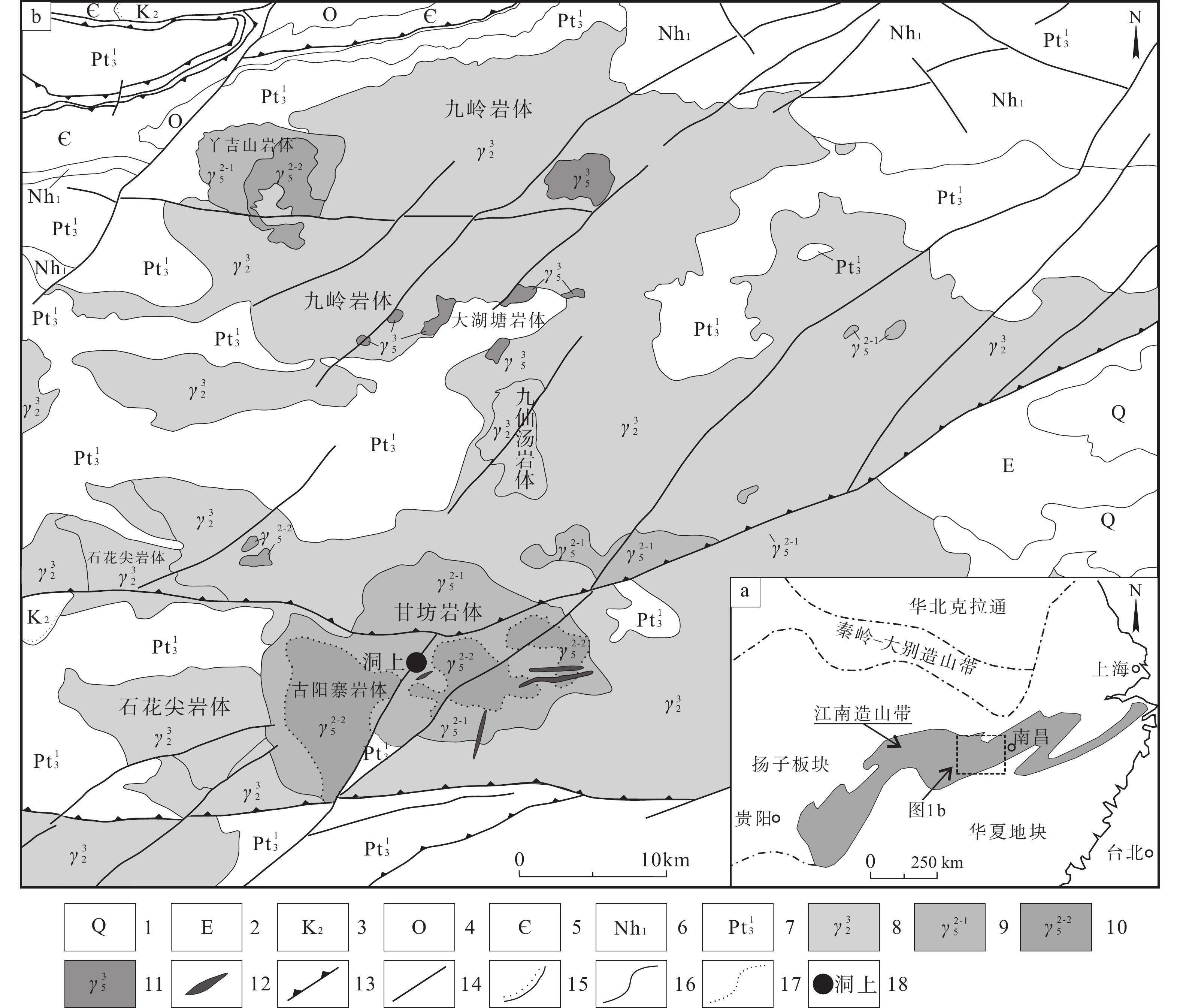
 下载:
下载:
